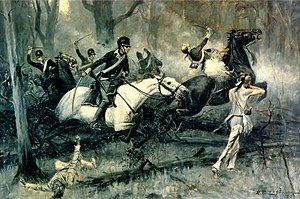Battle of Fallen Timbers: Difference between revisions
| Line 42: | Line 42: | ||
==External links== |
==External links== |
||
*[http://www.fallentimbersbattlefield.com/ The Fallen Timbers battlefield today] |
*[http://www.fallentimbersbattlefield.com/ The Fallen Timbers battlefield today] |
||
*[http://www.ohiohistorycentral.org/ |
*[http://www.ohiohistorycentral.org/entry.php?rec=473 Ohio History Central] |
||
*[http://ohioindianwars.proboards18.com/index.cgi Ohio Indian Wars Message Board] |
*[http://ohioindianwars.proboards18.com/index.cgi Ohio Indian Wars Message Board] |
||
Revision as of 19:53, 24 January 2006
| Battle of Fallen Timbers | |||||||
|---|---|---|---|---|---|---|---|
| Part of the Northwest Indian War | |||||||
 An 1896 depiction of the battle from Harper's Magazine | |||||||
| |||||||
| Belligerents | |||||||
| Blue Jacket's confederacy | United States | ||||||
| Commanders and leaders | |||||||
|
Blue Jacket Buckongahelas | Anthony Wayne | ||||||
| Strength | |||||||
| 1,500 | 3,000 | ||||||
| Casualties and losses | |||||||
| 40 |
33 killed 100 wounded | ||||||
The Battle of Fallen Timbers (August 20, 1794) was the final battle of the Northwest Indian War, a struggle between American Indians and the United States for control of the Northwest Territory. The battle, which was a decisive victory for the United States, ended major hostilities in the region until "Tecumseh's War" and the Battle of Tippecanoe in 1811.
Background
An Indian confederacy—one of the strongest Native American alliances to date—had achieved major victories over the United States in 1790 and 1791, alarming the administration of President George Washington. In 1792, Washington called upon Revolutionary War veteran General "Mad Anthony" Wayne to build and command a new army. Wayne believed the previous expeditions against the Indians had failed because of the poor training and discipline, and so he began rigorous preparations.
Wayne had plenty of time to train his new army, as peace negotiations were undertaken in the summer of 1793. The Americans sought to confirm possession of lands north of the Ohio River that they had claimed from Great Britain after victory in the American Revolutionary War. Indeed, the Americans were already moving into the Ohio lands.
However, Shawnee war chief Blue Jacket and Delaware (Lenape) leader Buckongahelas, encouraged by their recent victories over the United States and the hope of continued British sponsorship, pressed for the Ohio River boundary line established by the Treaty of Fort Stanwix in 1768; they rejected subsequent treaties that had ceded lands north of the Ohio River to the United States. A faction of Indians led by the influential Mohawk leader Joseph Brant attempted to negotiate a compromise, but Blue Jacket and his allies would accept nothing less than an Ohio River boundary, which the United States refused.
Battle
Wayne's new army, the Legion of the United States, marched north from Fort Washington (Cincinnati, Ohio) in 1793, building a line of forts along the way. Wayne commanded more than 3,000 men, with some Choctaw and Chickasaw Indians serving as scouts.
Blue Jacket's army took a defensive stand along the Maumee River (not far from present-day Toledo, Ohio), near a number of uprooted trees ("fallen timbers") that had been leveled by a tornado or heavy storm. They reckoned that the trees would hinder the advance of the army, if they came. Nearby was Fort Miamis, a British outpost from which the Indian confederacy received provisions. The Indian army, about 1,500 strong, consisted of Blue Jacket's Shawnees and Buckongahelas's Delawares, Miamis led by Little Turtle, Wyandots, Ojibwas, Ottawas, Potawatomis, Mingos, and even some Canadian militia.
The battle did not last long. Not only were the Indians greatly outnumbered—many were getting provisions from the fort when the battle began—they were also outflanked by American cavalry. The Indians were quickly routed, and fell back to Fort Miamis, only to find the gates closed. The British commander, not authorized to start a war with the Americans, refused to give shelter to the fleeing Indians. The American troops destroyed Indian villages and crops in the area, and then withdrew. Each side lost about 40 men.
The defeat of the Indians led to the signing of the Treaty of Greenville in 1795, which ceded much of present-day Ohio to the United States, paving the way for the creation of that state in 1803. One veteran of Fallen Timbers who did not sign the Greenville treaty was a young Shawnee war leader named Tecumseh, who would renew Indian resistance in the years ahead.
References
- Sudgen, John. Blue Jacket: Warrior of the Shawnees. Lincoln, Nebraska: University of Nebraska Press, 2000.
- Sword, Wiley. President Washington's Indian War: The Struggle for the Old Northwest, 1790-1795. Norman, Oklahoma: University of Oklahoma Press, 1985.
